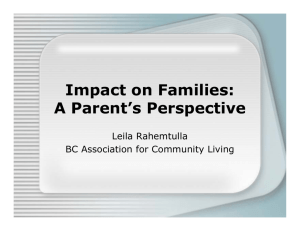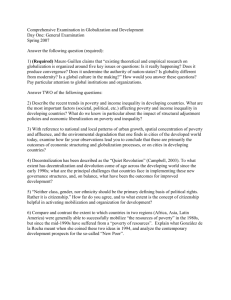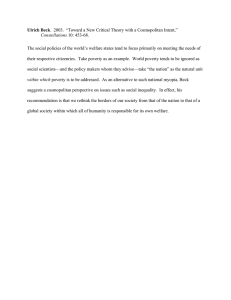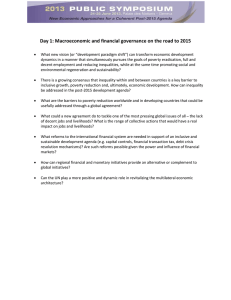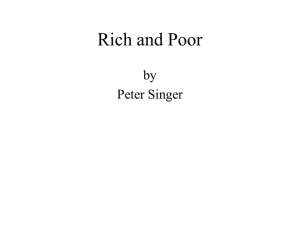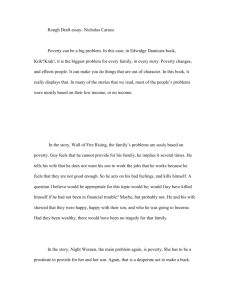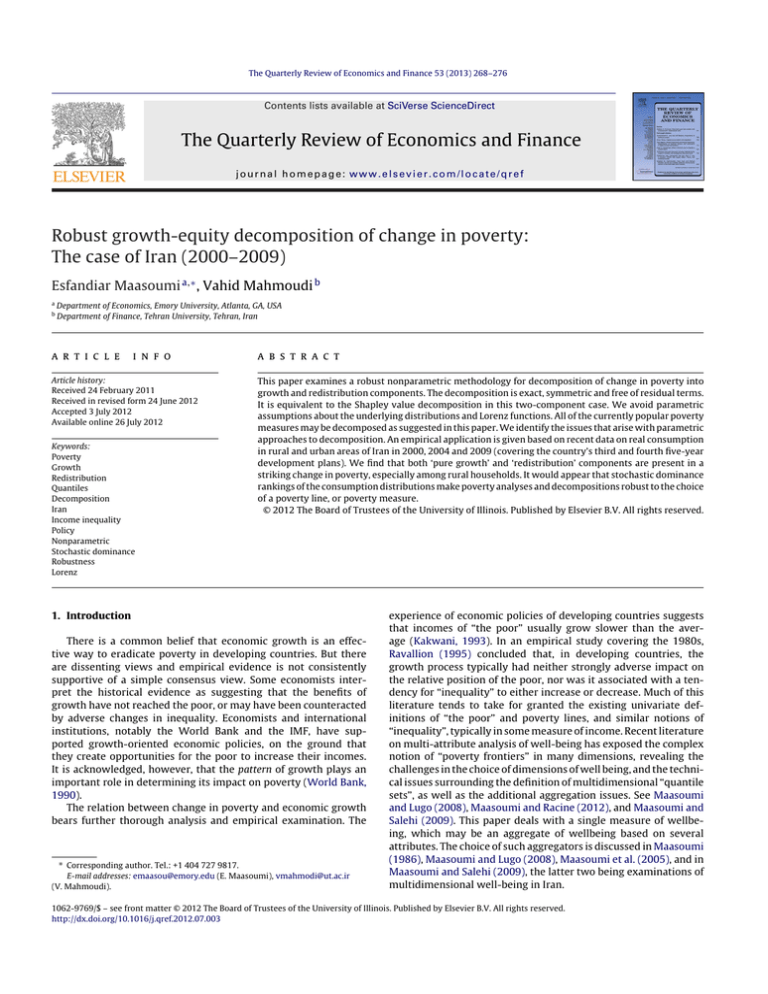
The Quarterly Review of Economics and Finance 53 (2013) 268–276
Contents lists available at SciVerse ScienceDirect
The Quarterly Review of Economics and Finance
journal homepage: www.elsevier.com/locate/qref
Robust growth-equity decomposition of change in poverty:
The case of Iran (2000–2009)
Esfandiar Maasoumi a,∗ , Vahid Mahmoudi b
a
b
Department of Economics, Emory University, Atlanta, GA, USA
Department of Finance, Tehran University, Tehran, Iran
a r t i c l e
i n f o
Article history:
Received 24 February 2011
Received in revised form 24 June 2012
Accepted 3 July 2012
Available online 26 July 2012
Keywords:
Poverty
Growth
Redistribution
Quantiles
Decomposition
Iran
Income inequality
Policy
Nonparametric
Stochastic dominance
Robustness
Lorenz
a b s t r a c t
This paper examines a robust nonparametric methodology for decomposition of change in poverty into
growth and redistribution components. The decomposition is exact, symmetric and free of residual terms.
It is equivalent to the Shapley value decomposition in this two-component case. We avoid parametric
assumptions about the underlying distributions and Lorenz functions. All of the currently popular poverty
measures may be decomposed as suggested in this paper. We identify the issues that arise with parametric
approaches to decomposition. An empirical application is given based on recent data on real consumption
in rural and urban areas of Iran in 2000, 2004 and 2009 (covering the country’s third and fourth five-year
development plans). We find that both ‘pure growth’ and ‘redistribution’ components are present in a
striking change in poverty, especially among rural households. It would appear that stochastic dominance
rankings of the consumption distributions make poverty analyses and decompositions robust to the choice
of a poverty line, or poverty measure.
© 2012 The Board of Trustees of the University of Illinois. Published by Elsevier B.V. All rights reserved.
1. Introduction
There is a common belief that economic growth is an effective way to eradicate poverty in developing countries. But there
are dissenting views and empirical evidence is not consistently
supportive of a simple consensus view. Some economists interpret the historical evidence as suggesting that the benefits of
growth have not reached the poor, or may have been counteracted
by adverse changes in inequality. Economists and international
institutions, notably the World Bank and the IMF, have supported growth-oriented economic policies, on the ground that
they create opportunities for the poor to increase their incomes.
It is acknowledged, however, that the pattern of growth plays an
important role in determining its impact on poverty (World Bank,
1990).
The relation between change in poverty and economic growth
bears further thorough analysis and empirical examination. The
∗ Corresponding author. Tel.: +1 404 727 9817.
E-mail addresses: emaasou@emory.edu (E. Maasoumi), vmahmodi@ut.ac.ir
(V. Mahmoudi).
experience of economic policies of developing countries suggests
that incomes of “the poor” usually grow slower than the average (Kakwani, 1993). In an empirical study covering the 1980s,
Ravallion (1995) concluded that, in developing countries, the
growth process typically had neither strongly adverse impact on
the relative position of the poor, nor was it associated with a tendency for “inequality” to either increase or decrease. Much of this
literature tends to take for granted the existing univariate definitions of “the poor” and poverty lines, and similar notions of
“inequality”, typically in some measure of income. Recent literature
on multi-attribute analysis of well-being has exposed the complex
notion of “poverty frontiers” in many dimensions, revealing the
challenges in the choice of dimensions of well being, and the technical issues surrounding the definition of multidimensional “quantile
sets”, as well as the additional aggregation issues. See Maasoumi
and Lugo (2008), Maasoumi and Racine (2012), and Maasoumi and
Salehi (2009). This paper deals with a single measure of wellbeing, which may be an aggregate of wellbeing based on several
attributes. The choice of such aggregators is discussed in Maasoumi
(1986), Maasoumi and Lugo (2008), Maasoumi et al. (2005), and in
Maasoumi and Salehi (2009), the latter two being examinations of
multidimensional well-being in Iran.
1062-9769/$ – see front matter © 2012 The Board of Trustees of the University of Illinois. Published by Elsevier B.V. All rights reserved.
http://dx.doi.org/10.1016/j.qref.2012.07.003
E. Maasoumi, V. Mahmoudi / The Quarterly Review of Economics and Finance 53 (2013) 268–276
As an empirical matter, to understand the “contribution” of
“growth” and “redistribution” to changes in poverty, one needs
robust measurement of its components, one being the growth in
average income, and the other being the redistribution of income.
This is difficult, as has been pointed out by Shorrocks (1999), who
singles out a number of problems with existing decomposition
approaches.
Several methods for decomposition of poverty changes have
been proposed, for example by Kakwani and Subbarao (1990), Datt
and Ravallion (1992), Shorrocks (1999), and Tsui (1996). Shorrocks
(1999) is based on Shapley (1953), and extending Owen (1977),
when there is a hierarchical set of attributes and components. The
Shapley approach is compatible with our method here where there
is symmetry with respect to the order in which the contribution of
each of our two components (growth and inequality) is eliminated.
The Datt and Ravallion and other approaches extant, tend to have
several limitations. Firstly, the growth and redistribution components are not symmetric with respect to the base and final years,
or the elimination process. Secondly, the decompositions are not
exact and contain a ‘residual’ component (see the next section).
A more desirable decomposition method is one that exactly sums
the contributions of determining factors of total changes. A further limitation of the current methods is due to their specificity
with regards to measures of inequality or poverty. Another, less
widely appreciated limitation is due to parametric choice of the
distribution function (alternately, the Lorenz functions). This paper
proposes a nonparametric method for estimating the components
of change in poverty (growth and redistribution components) and
illustrates the proposed approach with recent data for Iran. We are
able to exactly decompose poverty changes into two components,
based on the empirical CDF (cumulative distribution function),
without residuals, and symmetrically with respect to the reference
point in time. Our components are estimated and statistical significance is indicated for each component of change in poverty. This
paper is about “measurement” to accurately identify certain well
defined components of changes in the distribution of a measure of
well being. It is not about identifying economic policies that may be
conducive to “growth” or “equality”, much less the mechanism by
which such policies may be transmitted. Our measures help establish “what is” the state of poverty, at various points in time. This
provides an “equilibrium metric” which may be helpful in evaluating economic outcomes. Attribution to specific economic policies
is a far more challenging task that is not addressed in this paper.
The paper is organized as follows. Section 2 presents a short
review of economic growth, inequality and poverty, including in
Iran. Section 3 exemplifies current decomposition methods such as
the one described in Datt and Ravallion (1992). Section 4 describes
our proposed approach to decomposing these effects. Section 5 provides a sketch of recent experience in Iran. Section 6 presents our
empirical application of the proposed methodology to recent data
on real consumption in rural and urban areas in Iran in 2000, 2004
and 2009. Conclusions are in Section 7.
269
reduction. Challenges to this view have emerged with conflicting
empirical evidence since 1990s. Some believe economic growth
benefits the poor; others see it as ultimately detrimental to the
poor. Although there are other ideas that exist between these two
extreme beliefs, most of them are somewhat in agreement with the
relationship between growth-poverty and also inequality-poverty
(especially the second relationship). The empirical evidence which
would appear to contradict these “relationships” is exemplified
by Ravallion (1995), who argues that in developing countries, the
growth process has not had a significant negative effect on the relative situation of the poor, while according to Fosu (2011), in most
developing countries, growth has been the main factor decreasing
poverty. The diversity of the inferences increases when inequality
changes are examined as well. For instance, some have suggested
that China has been able to reduce poverty without increasing
inequality (Ravallion & Chen, 2007), while in Botswana economic
growth has not reduced poverty (Fosu, 2011).
The decomposition of poverty changes into the two components of growth and inequality plays an important role in clarifying
these issues, without attributing causal relations to specific policies. Studies like those of Datt and Ravallion (1992) and Kakwani
(1993) are important primary examinations of this kind. There are
also empirical studies of poverty changes in Iran. These include
Piraee (2004) who has decomposed the poverty changes of the first
development plan into three areas: urban areas, rural areas and the
whole economy. The results show that in all three areas, growth
has been “associated” with a rise in poverty, while inequality has
had a positive association. Mahmoudi (2001) has also provided a
decomposition in urban and rural areas during the first plan in Iran.
His results indicate an association between reduced poverty and
both net growth and redistribution, especially in rural areas. SalehiIsfahani (2006) has examined the association between growth,
inequality and poverty over 25 years since the Islamic revolution of
1979. His findings indicate an improvement in poverty and growth
indicators over that period. Salehi-Isfahani (2009) examined the
same association between poverty, inequality and growth during
different presidencies. He concluded that poverty has been consistently decreasing with growth, but inequality has remained stable.
We will examine these questions for Iran based on our techniques,
for the decade ending in 2009.
3. Growth-equity decomposition of a change in poverty
Let x denote income, F(x) denote its cumulative distribution
function (proportion of population with income less than x), and
L(F; p) the Lorenz curve, giving the fraction of total income that
the holders of the lowest pth fraction of incomes possess. Lorenz
curve is a mean-normalized integral of the inverse of a distribution
function
L(p) =
1
p
F −1 () d
(1)
0
If L (p) denotes the slope of the Lorenz curve, then:
2. A brief review of the relationship between economic
growth, inequality and poverty
The debate concerning the relationship between growth and
poverty, and inequality and poverty, has a long history, going
back to Ricardo and Malthus, and the more recent “inverted U”
curve of Kuznets (1955). Generally the pre 1970s view is one
of “exchange” between growth and poverty. In the 1970s there
was a shift toward poverty reduction independent of growth (for
instance, see Chenery & Ahluwalia, 1974). During the next decade
and later, growth has been considered as necessary for poverty
x = F −1 (p) = L(p)
where is mean income. The distribution function evaluated at the
poverty line is the well-known “headcount ratio” poverty index. For
a poverty line z, and the poverty rate, P0 :
L(P0 ) =
z
(2)
From (2) it is clear that any change in the poverty rate P0 may
be related to the change in the Lorenz curve, L (F; p) and the change
in mean income, . These are the two components whose effects
270
E. Maasoumi, V. Mahmoudi / The Quarterly Review of Economics and Finance 53 (2013) 268–276
we seek to identify. Aggregate additive poverty measures can be
expressed in a general form by:
P(F; z) = p(LF , F , z) = p̃(LF , ıF , ız )∀ı by scale invariance
= p̃ LF , 1,
z
F
∀ı = 1/F = p̃˜ LF ,
z
F
(3)
where z is the absolute poverty line, F is the mean income
per capita and, LF is the Lorenz curve corresponding to F. Datt
and Ravallion (1992) point out that decomposition of changes in
poverty between two dates (t = 1, 2) can be written as the sum of a
growth component (PG ), a redistribution component (PR ) and
a “residual” or error term (e),1
P = P
z
2
; L2
z
+ P
1
−P
; L2
z
1
−P
; L1
z
1
z
= P
; L1
2
; L1
−P
z
1
; L1
+ residual = P G + P R + e
(4)
Where the initial year is taken as the reference point. To implement
this decomposition Datt and Ravallion (1992) proposed formulas
based on the class of Foster, Greer and Thorbecke (GFT) poverty
indices (P˛ ) using a parametric form of the Lorenz curve. There are
a number of ways of specifying a parametric form for the Lorenz
curve (or the underlying distribution). Two examples are the Beta
model of Kakwani (1980) and the general quadratic (GQ) model
of Villasenor and Arnold (2000) which Datt and Ravallion used in
their paper.
One interpretation is that the residuals indicate miss-specified
components in the decompositions. Indeed, the “residual” in
Datt–Ravallion’s method shows the inability of the method to separate pure growth and redistribution components completely, in
addition to the sensitivity of the various components to the parametric choice of the underlying distribution.
To demonstrate the sensitivity of component estimates to the
choice of the “reference point” in this approach, Datt and Ravallion
(1992), Table 6, reports a redistribution component of −1.95. But
reversing the reference and terminal points, a value of −0.54 may be
computed for redistribution (computation is based on their footnote 3)! Given the total change in poverty is −1.20, the example
shows the importance of this lack of invariance to reference point
selection. To overcome the problem, one solution is to take an average of the two decompositions, thus eliminating the residual.2 This
averaged change is given below:
P = P
+
z
2
; L2
−P
z
1
; L1
=
1
[G(1, 2, r1 ) + G(1, 2, r2 )]
2
1
[R(1, 2, r1 ) + R(1, 2, r2 )] = P G + P R
2
(5)
where ri refers to the reference date and G and R functions refer to
growth and redistribution respectively. Eq. (5) indicates that there
are only two components. In the Shapley decomposition proposed
by Shorrocks (1999), averaging over all sequences in which each of
a number of components are eliminated, removes the residual as
well.
4. An alternative approach
The most commonly used measures of poverty are the headcount, the poverty, and the poverty sensitive indices. These indices
1
The residual is the difference between the growth (redistribution) components
evaluated at the final and initial Lorenz curves (mean incomes).
2
Datt and Ravallion (1992) do mention this point. They state that it is arbitrary.
Fig. 1. A CDF based growth-redistribution decomposition of the change in poverty.
are fully defined as functions of the cumulative distribution of
income and a poverty line.3 Given the direct relationship between
the distribution function (CDF) and the poverty measures, relying
on the changes in the CDF to decompose poverty changes is natural
and often better implemented empirically, and nonparametrically.
This method is also more easily related to other fundamental concepts such as stochastic dominance. The latter are partial rankings
which avoid cardinal choice of both the distribution functions and
poverty measures. Dominance rankings are also testable with new
statistical procedures; see Davidson and Duclos (2000), and Linton,
Maasoumi, and Whang (2005, 2007).
4.1. A nonparametric decomposition
An exact, simple, nonparametric approach to decompose a
change in poverty into growth and redistribution components is
introduced here based on the empirical CDF (alternately, empirical
Lorenz curve). Denote the CDF and poverty line at time t by Ft and zt ,
respectively, so that Ft (x) represents the proportion of households
with income less than or equal to x at time t.
The change in a poverty index, P, may be represented as follows:
P = P(F2 ; z) − P(F1 ; z).
(6)
We assume that “income” is expressed in real terms, and the
poverty line is the same at both dates (z1 = z2 = z). The “pure growth”
component is obtained by the ratio of changes in the two mean
incomes. If all incomes in period 1 are scaled up by = 2 /1 where
1 and 2 are the mean incomes, one can construct a new intermediate distribution F1∗ . This is illustrated in Fig. 1.
3
The additive class of poverty measures developed by Foster, Greer, and
Thorbecke (1984) can be expressed in a continuous form as: P˛ (F; z) =
(1/z ˛ )
F(z)
0
[z − F −1 (p)] dp,
˛ ≥ 0, where ˛ measures the aversion to poverty
among the poor. When this parameter equals zero, the above aggregate poverty
measures collapses to the well-known head count index – the percentage of people
with an income below the poverty line. The headcount index is totally insensitive
to differences in the depth of poverty. Concerns about the depth of poverty may be
factored in just by getting the poverty aversion parameter to unity. This yields the
poverty gap index which is a normalized sum of the shortfalls of the poor. These
two indices are not sensitive to the distribution among the poor. Considering ˛ = 2
overcome this problem which is a weighted sum of shortfalls of the poor, where
the weights are the shortfalls themselves. Thus it attaches greater weight to lower
incomes amongst the poor.
E. Maasoumi, V. Mahmoudi / The Quarterly Review of Economics and Finance 53 (2013) 268–276
In this example, F2 first order stochastically dominates F1 for
two possible reasons, one is a possible mean shift, the other is a
possible reduction in “inequality”. By constructing a potential distribution which differs from the original only by the mean shift, and
no other distribution changes, one can sort out the two components
of the movement between the two distributions. This is similar to
the Shapley elimination sequence. Suppose the initial income distribution, F1 (with mean 1 ) shifts to the right in a distributionally
neutral fashion, yielding F1∗ with the same mean 2 as F2 . Because F1
and F2 have the same mean by construction, the graphs would cross
each other if there is redistribution. For F1∗ , the poverty line z implies
a headcount ratio of H* (alternatively, by defining an equivalently
adjusted poverty line, z/, with income growth factor , referencing
F1 ). The “pure growth” effect of poverty would be equal to H* − H1
and the redistribution effect is equal to H2 − H*. Therefore,
F1∗ (x)
= F1 (x) for all x
(7)
Equivalently:
F1∗ (x) = F1
x
F1∗
where
is the F1 distribution only scaled up to the same mean as
F2 . Thus, the poverty change may be additively decomposed into
the growth and redistribution effects as follows:
G
R
P = P + P =
[P(Fz∗ ; z) − P(F1 ; z)] +
P(F2 ; z) − P(F1∗ ; z)
2 L2 (p) − L1∗ (p) =
p
F2−1 () − F1∗−1 ()
d.
To illustrate the approach more specifically, we focus on the
headcount ratio. The change in headcount ratio can be written as:
H = H(F2 ; z) − H(F1 ; z) = F2 (z) − F1 (z)
(9)
(10)
Then the change in headcount ratio attributable to the growth
effect, denoted by HG , is represented by:
H G = H(F1∗ ; z) − H(F1 ; z) = F1∗ (z) − F1 (z) = F1
= F1
z
z − F1 (z)
1
(11)
2
Similarly, the change in headcount ratio attributable to redistribution, denoted by HR is:
H R = H(F2 ; z) − H(F1∗ ; z)
(12)
So far F1 has been taken as the reference distribution with a
pure growth effect being a proportional increase in all incomes.
Suppose now that F2 is taken as the reference distribution and the
pure growth effect is a proportional decrease in all incomes. If all
incomes are scaled down proportionately by , then we have a new
distribution F2∗ :
F2∗
(8)
We may further clarify how the CDF can be used to reveal a pure
‘redistribution’ effect. Since F2 and F1∗ have the same mean 2 by
construction, we can write:
271
x
= F2 (x) for all x,
F2∗ (x)
(13)
or
= F2 (x)
F2∗ is the F2 distribution scaled down to the same mean as F1 . We
can now decompose the poverty change as:
P = P G + P R = P(F2 ; z) − P(F2∗ ; z) + P(F2∗ ; z) − P(F1 ; z)
(14)
0
This shows that redistribution (Lorenz changes) is captured by
CDF changes when the mean is the same. One may recall that this is
the advantage of Generalized Lorenz (mean unadjusted Lorenz!),
for measuring Second Order stochastic dominance between distributions with unequal means! See Shorrocks (1983). Note that
the analysis does not depend on a first order dominance ranking
as in Fig. 1. Indeed, two other possible situations are straightforward extensions of this graphical depiction. One is when the first
distribution crosses the second above any poverty line of interest
with second order dominance. The other is when the distributions
cross at a sufficiently “high” quantile for second order dominance
to hold generally. Note that when the distributions cross, existence of second order dominance depends on the concavity of the
welfare function, i.e., its relative aversion to unequal distributions.
Thus with crossing CDFs, ranking of poverty states, and decompositions, depend on areas under the CDF functions up to the poverty
line. Later on in this paper we will offer the corresponding decompositions for the FGT family of poverty measures with different
underlying degrees of distributional sensitivity. Statistical tests for
second order rankings, possibly up to a desired poverty line, are
given in the literature; e.g., see Linton et al. (2005, 2007). One
robust approach is to first test for statistically significant ranking
of distributions, find the poverty line below which such ranking
is uniform, and then compute the two components as offered in
this paper. Such an approach will have an additional robustness
property toward the choice of a poverty line. When rankings are
established for points above any conventional poverty lines, discussion of an “ideal” poverty line is rendered moot. This happens
to be the case in our empirical example for Iran! In our implementation, the CDFs are estimated by the empirical CDFs, which avoid
parametric specification and identification of Lorenz curves. It is a
fundamental statistical property that empirical CDF is generally a
consistent estimator of the true CDF.
Thus, there are two possibilities for decomposition: one referencing the initial distribution and the other referencing the final
distribution. To avoid this index-numbers issue we take an average of (8) and (14). Contributions of growth and redistribution on
poverty changes can be expressed “symmetrically” as follows4
P G =
1
[P(F1∗ ; z) − P(F1 ; z) + P(F2 ; z) − P(F2∗ ; z)]
2
P R =
1
[P(F2 ; z) − P(F1∗ ; z) + P(F2∗ ; z) − P(F1 ; z)]
2
or equivalently as:
P G =
z
1
P
2
2
, L1
−P
z
1
, L1
=
1
[G(1, 2, r1 ) + G(1, 2, r2 )]
2
=
z
1
P F1 ;
2
P R =
z
1
P
2
=
2
z
2
, L2
−P
− P(F1 ; z) + P(F2 ; z) − P(F2 ; z)
, L2
+P
(15)
−P
z
2
, L1
+P
z
1
, L2
−P
z
1
, L1
∀ =
z
1
2
1
, L1
1
[R(1, 2, r1 ) + R(1, 2, r2 )]
2
This is exactly the same as (5) but with different derivation.
There is no residual intrinsically, i.e., this is an exact decomposition in which eliminating one of the two components directs all
contribution to the remaining component. This is a main property
of Shapley-type decompositions. Empirically, a parametric choice
4
Shorrocks (1999) also derives a similar average result by appeal to Shapley value.
272
E. Maasoumi, V. Mahmoudi / The Quarterly Review of Economics and Finance 53 (2013) 268–276
for the Lorenz curve is possible but unnecessary. Empirical CDF
or smoothed nonparametric methods provide inferences that are
robust to parametric misspecifications.
4.2. Some issues with parametric decompositions
To highlight some of the drawbacks of specific parametric
choices of the Lorenz functions, here we derive the decomposition
formula based on specific choices suggested in Kakwani (1993),
who argues that the Lorenz curve change can be summarized by:
L2 (p) = L1 (p) − [p − L1 (p)
(16)
which suggests that when > 0 ( < 0), it shows a downward
(upward) shift in the Lorenz curve resulting in higher (lower)
inequality. Kakwani argues that is equal to proportional change
in the Gini index of inequality. If = 0.01 (−0.01), it indicates that
the Gini index has risen (fallen) 1%.
Recall that the slope of Lorenz curve in the final distribution
evaluated at the poverty line can be represented as:
L2 (H 2 ) =
z
2
L 2 (H 2 ) = L1 (H 2 ) − [1 − L1 (H 2 ).
(18)
z∗
.
2
z + 2
.
(1 + )
dH z
.
dz H
(20)
P = P(F1∗ ; z) − P(F1 ; z) + P(F1∗ ; z ∗ ) − P(F1∗ ; z) + residual
(21)
Alternatively, when the final distribution is the reference, (8)
can be expressed as:
P = P(F2 ; z) − P(F2∗ ; z) + P(F2∗ ; z) − P(F2 ; z ∗∗ ) + residual
where
z + 1
z ∗∗ =
(1 + )
(25)
Expression (11) allows us to focus on the initial distribution in
order to see the impact of changes in mean income on poverty.
Hence, from (24) and (25) it is possible to define the growth component of the headcount ratio changes as follows:
H G ≈ (z −
The change in poverty given in (8) can be rewritten as:
H =
(19)
Substituting (17) and (19) in (16) gives (Kakwani, 1993):
(24)
and the elasticity of headcount ratio with respect to poverty line
can be stated as:
For the Lorenz curve L1 (p), H is the proportion of individuals
with income less than or equal to z such that L1∗ (H ∗ ) = z/2 . When
substituting H2 for H in this equation, z must change to a new level
z* . In that case:
z∗ =
dH = F(z)dz
(17)
Differentiating of (16) with respect to p at p = H2 , yields
L 2 (H 2 ) =
poverty components based on the slope of the distribution function around the poverty line. The reduction in poverty depends on
where the poor are in relation to the poverty line. If they are concentrated just below the line, the increase in their income will have a
bigger effect on poverty than if they are spread more evenly below
the line. Hence the slope of distribution function at the poverty
line is an important determinant of the incidence of poverty (headcount ratio). In other words, if the density of households around the
poverty line is generally high, we can expect poverty to be highly
elastic with respect to the poverty line. If the slope is less steep it
implies that few people are located immediately below the poverty
line. In this case the same increase in income moves only a few of
the poor above the poverty line and the reduction in the incidence
of poverty (headcount ratio) will be much smaller (World Bank,
1990).
Using the slope of the distribution function as a determining
component of poverty changes, and holding the distribution function constant, the change in headcount ratio is:
z −1
2 − 1
H 1 H(F1 ; z)
)F 1 (z) =
H 1 H(F1 ; z) =
2
(26)
where H 1 is the elasticity of the headcount ratio F1 (z), with respect
to the poverty line and defined as before. Alternatively, starting
from F2 the “pure growth” effect is given by:
H G ≈ ( − 1)F 2 (z)z = ( − 1)H 2 H(F2 ; z) =
2 − 1
H 2 H(F2 ; z)
1
(27)
(22)
(23)
The residuals in (22) and (23) vanish if the Lorenz curve remains
unchanged over the decomposition period, which is when all of the
change in poverty is due to the growth component. When there is
no redistribution (no change of inequality), there is no residual.
When there is redistribution, each parametric form will represent
it in a form specific to that parametric form. But inequality in a distribution can be parameterized and “indexed” in numerous ways.
Thus parametric numerical estimates lack invariance to the choice
of functional forms and indices. Nonparametric methods, based on
the CDF are invariant, and robust, in this sense.
It would seem that a nonparametric implementation of the
general decomposition formula in (15) would avoid many of the
highlighted problems with residuals and asymmetry.
where H 2 is the elasticity of the headcount ratio, F2 (z) with respect
to the poverty line.
Headcount ratio is insensitive to the “intensity of poverty”,
that is the distribution of poverty below the poverty line. But, our
approach can be extended to members of P˛ family of measure
which includes the headcount ratio. Similar to (26) and by normalizing the “poverty deficit curve” with poverty line (z), and the
“poverty severity curve” by z2 /z we can express the contribution of
changes in P˛ caused by ‘pure growth’ effect as5 :
P˛G =
1
2
P˛,1 P˛ (F1 ; z) +
1
P P˛ (F2 ; z)
1 ˛,2
(28)
where P˛ is the elasticity of P˛ with respect to the poverty line.
Notice that (29) is an average of the two decompositions, first using
the initial year as the reference and next using final year as the
reference.
4.3. An elasticity-based presentation of our approach
5
This section aims to explain the decomposition process in an
alternative way, using an elasticity approach. This further clarifies
the method and would also help to obtain an approximation of the
2 − 1
2
The “Poverty Deficit Curve”
(PDC), defined as the area under CDF up to some
poverty line z: D(F; z) =
z
0
F(x) dx = zP1 (F; z). The “Poverty Severity Curve” is
the area underneath the PDC up to some poverty line z: S(F; z) =
(1/2)z 2 P2 (F; z); (see Ravallion, 2004 and Deaton, 1997).
z
0
D(x) dx =
E. Maasoumi, V. Mahmoudi / The Quarterly Review of Economics and Finance 53 (2013) 268–276
273
Table 1
Descriptive statistics.
Mean
Maximum
Minimum
Std. Dev.
Rural Gini
Urban Gini
Economic growth
0.399236
0.418100
0.383700
0.009937
0.413009
0.420300
0.406100
0.004701
06.5762
12.8199
−4.2923
5.3101
Sources: Statistical Center of Iran and Central Bank of Iran.
Fig. 4. Gini coefficient in rural Iran.
Table 2
Correlation coefficients.
Y
RU
RG
Y
RU
RG
1
–
–
−0.4399
1
–
−0.6021
0.3917
1
Fig. 2. Economic growth in Iran.
5. A brief review of growth and redistribution of income in
Iran
In the period before 2009, economic growth and the Gini coefficient in urban and rural areas of Iran indicate that growth in
incomes has accompanied a more equal distribution, generally,
while inequality between the urban and rural areas has increased
somewhat. Regional inequality in rural areas has a higher variance
than the urban parts of the country.
To exemplify, we provide a sketch of growth and income distribution in rural and urban areas of Iran for the period 1997–2007.
The sources of all the statistical data here are the office of Bureau of
Population, labour force statistics, and a census which is affiliated
with Statistical Center of Iran. Table 1 displays a summary of the
Gini and annual income growth for this period.
Fig. 2 shows the lowest and highest growth occurred in 1998
(−4.29%) and 2002 (12.81%), respectively. This suggests that,
although the average growth rate over this period is high (about
6.5%), it has fluctuated.
Fig. 3 shows, the difference between the lowest and highest Gini
coefficient in urban areas is small (0.02), with the largest inequality
recorded in 1997, and smallest in 2005, with an average of 0.41 in
urban areas.
Fig. 3. Gini coefficient in urban areas of Iran.
Fig. 4 shows that the largest and least inequalities in rural areas
occurred in 1998 and 2003, respectively. Moreover, the average of
rural Gini is near 0.4, not very different from the urban average
over the same period. We note that while Gini is the most commonly reported index, it is notoriously insensitive to tail areas of
distributions and would not adequately reflect the changes in such
areas. When extreme poverty reduction is a policy goal, Gini is not
the most appropriate measure of inequality.
The pattern of changes in Gini and economic growth is consistent with an inverse relation between growth and inequality. This
can be formalized by examining the correlations between these
two annual measures in Table 2.
Fig. 5 reveals that, except for the earlier part of the decade,
“within group” inequalities for urban and rural areas are quite
different. The “within rural” inequality declined more and is somewhat lower than “within urban” inequality.
Over this particular period income inequality in Iran is somewhat high compared to ‘average Gini coefficient’ of ‘High Income
Countries’, ‘Eastern Europe’ and ‘South Asia’ (Deininger & Squire,
1996). Income inequality in the whole country decreased during
the Islamic Republic’s third and forth five-year plans (2000–2009).
Other, more tail sensitive measures of inequality than Gini confirm
this view; see Maasoumi and Salehi (2009).
Fig. 5. Within group inequality – rural and urban groups.
274
E. Maasoumi, V. Mahmoudi / The Quarterly Review of Economics and Finance 53 (2013) 268–276
6. Decomposition of poverty changes in Iran
.2
.4
.6
.8
1
Distribution of Household Expenditure, Iran, 2000, 2004, 2009
0
The methodology developed in this paper (formula (15)) is
applied to adjusted consumption expenditure data obtained from
the Iranian household survey, conducted by Statistical Centre of
Iran (SCI). We draw on micro-data sets of SCI Budget Household
Survey (SCIBHS) for the years 2000, 2004 and 2009. The SCIBHS is a
nationally and regionally representative household survey carried
out by SCI. The sampling unit is a household. Information for the
SCIBHS was collected by personal interview over a 24-h period for
rural, and a 48-h period for urban areas, for food items, and month
by month for non-food items throughout the year. The sampling
methodology can be described as multi-stage random sampling
with geographical stratification and clustering. The sample size
for our analysis is as follows: the 2000 sample contains 26,941
households––54% rural households and 46% urban households. The
2004 sample covered 24,534 households––53% rural households
and 47% urban. The 2009 sample covered 36,869 households––49%
rural households and 51% urban. We focus on the distribution of
adjusted household expenditure.
In adjusting the data to the 2000 price levels we used a modified version of Iran’s consumer price index (CPI) for rural and urban
areas separately. The ordinary CPI is far from ideal for our purpose
because it is particularly problematic in the case of the dual-price
systems in transitional economies implementing adjustment policies. Following a policy in which coupon prices are gradually phased
out (as has partially occurred in Iran since 1989), using ordinary
CPI would not to be recommended because it fails to properly
reflect the inflation which poor households experience. We have
re-weighted the CPI so as to better reflect the consumption pattern
of the poorer households. Notice that, because of considerable differences in the cost of living, the data were adjusted by regional
CPI for urban and rural areas separately. The differences in needs
are considered by using an equivalent scale. For more detail see
Mahmoudi (2008) and Mahmoudi (2011).
Fig. 6 provides an overall picture of the dominance dynamics
in expenditures over this period of time. This provides a graphical
impression, without statistical measures of significance which may
be obtained from the stochastic dominance tests of Linton et al.
(2005).
The distribution in 2004 (right most) appears to first order dominate both of the distributions in 2000 and 2009, and 2009 (middle)
dominates 2000. This would suggest that poverty unambiguously
decreased during the third development plan (1999–2004), but
0
5000
10000
15000
20000
Household Expenditure per capita(1000 Rials)
Year 2000
Year 2009
Year 2004
Fig. 6. Distribution of household expenditure, Iran, 2000, 2004, 2009.
it increased during the fourth development plan (2004–2009).
Per capita constant absolute poverty line is about 2,500,000 Rials
(about $750 PPP) per the year 2000, see Mahmoudi (2008) and
Mahmoudi (2011). This renders moot the question of sensitivity of the empirical findings to the choice of a particular poverty
line. To highlight the factors that contributed most to the poverty
changes of urban and rural poverty over time, we decompose
poverty change between 2000 and 2004 and also between 2004
and 2009, into growth and inequality components. The results are
presented in Tables 3–6 based on the decomposition formula (15).
Where the growth component is the largest part of the change in
poverty it indicates that growth has played a more important role
than redistribution in achieving the change in poverty and vice
versa.
It should be noted that with FGT poverty measures, a decline in
poverty headcount ratio (P0 ) indicates that the number of household living below the poverty line declines; a decline in poverty
gap (P1 ) indicates that the average income of the poor households
increases; a decline in poverty severity (P2 ) indicates the poorest
benefit more than the “less” poor.
Table 3 illustrates that in urban areas the contribution of growth
is larger than that of the redistribution component. The most
Table 3
Decomposition of change in poverty into growth and redistribution components in urban areas of Iran, 2000, 2004.a,b
FGT
Period 1 (2000)
Period 2 (2004)
t-statisticc for 2000–2004 difference
Total change
Growth effect
Redistribution effect
P0
P1
P2
27.15
8.28
3.68
18.81
5.39
2.33
−3.8
−0.9
−3.7
−8.34
−2.89
−1.35
−5.83
−1.98
0.93
−2.51
−0.91
−0.42
a
b
c
The calculated values of P˛ have been multiplied by 100.
1000s of Rials ($1 > 9000 Rials).
t = (P˛04 − Pa00 )/standard error of P˛04 − Pa00 . Standard error of P˛ is an estimate of the asymptotic variance of poverty ( = t/p =
N
i=1
N
wj hj j /
i=1
wj hj ) that is;
AV() = 1/p2 [Var (t) + 2 (p) − 2cov(t, p)], where wj is sampling weight, hj is household size; in the case of, P˛ , j = ˛ (yj ) = I(yj < z)[1 − yj /z]a (Cowell, Howes, & Jenkins, 2004;
Howes & Lanjouw, 1998).
Table 4
Decomposition of change in poverty into growth and redistribution components in rural areas of Iran, 2000, 2004.a,b .
FGT
Period 1 (2000)
Period 2 (2004)
t-statisticc for 2000–2004 difference
Total change
Growth effect
Redistribution effect
P0
P1
P2
35.94
12.2
5.2
27.96
8.43
23.77
−6.4
−5.8
−6.2
−7.98
−3.77
−1.45
−5.95
−2.23
−0.90
−2.03
−1.54
−0.55
a, b, c: The same as Table 3.
E. Maasoumi, V. Mahmoudi / The Quarterly Review of Economics and Finance 53 (2013) 268–276
275
Table 5
Decomposition of change in poverty into growth and redistribution components in urban areas of Iran, 2004, 2009.a,b .
FGT
Period 1 (2004)
Period 2 (2009)
t-statisticc for 2004–2009 difference
Total change
Growth effect
Redistribution effect
P0
P1
P2
18.81
5.39
2.33
25.20
8.45
3.25
−3.5
−1.1
−3.8
6.39
3.06
0.92
5.50
2.55
0.69
0.89
0.51
0.23
a, b, c: The same as Table 3.
Table 6
Decomposition of change in poverty into growth and redistribution components in rural areas of Iran, 2004, 2009.a,b .
FGT
Period 1 (2004)
Period 2 (2009)
t-statisticc for 2004–2009 difference
Total change
Growth effect
Redistribution effect
P0
P1
P2
27.96
8.43
3.77
35.11
12.08
5.02
−5.8
−5.3
−6.7
7.15
3.65
1.25
6.13
2.70
0.95
1.02
0.95
0.30
a, b, c: The same as Table 3.
striking finding is that the redistribution component is negative
for all poverty measures!
Equally striking is the finding that all poverty measures show a
decline in rural areas. Both the increase in mean consumption and
redistribution are notable components of the decrease in poverty
in rural areas (Table 4).
Estimates in Tables 5 and 6 indicate poverty has somewhat
increased between 2004 and 2009. The growth component is the
largest part of the change in poverty during the fourth development
plan.
Our findings are generally consistent with earlier views of association between poverty and inequality. Prior findings have been
influenced by estimates of Gini which, as we noted, may not be a
good measure of changes in the tail areas, where the poor reside by
definition. Our examination is therefore able to uncover changes
that are free of parametric specifications of the distributions, and
are based on poverty measures that have increasing sensitivity to
changes in the tail areas. Poverty indices (especially P1 ) are also
useful to estimate the size of the resources needed to “eradicate”
poverty. If it were possible to perfectly target resources to the
poor, then, in 2004 a total amount of 11,470 milliard Rials (P1 × the
poverty line × population) would have been needed to bring the
expenditure of all poor households up to the level of poverty line.6
This represents about 2.5% of real GDP in that year.
7. Conclusions
The present method has the merit of exact decomposition without residuals and the simplicity and robustness of nonparametric
implementation. We decompose the aggregate value of poverty
changes which are estimated directly from conventional poverty
indices rather than from specific parametric functional forms of
Lorenz curves. This affords much needed robustness, and avoids
mis-specification issues. Our approach is applicable to all decomposable poverty measures. We have also highlighted the value of
examining robustness to the choice of poverty lines by means of
dominance ranking of distributions. When dominance to an appropriate order holds only beyond most reasonable “poverty lines”, a
further degree of robustness is gained.
6
P1 × the poverty line × population (nzP1 ) represents the amount of resources
required to eradicate poverty. Total income of the poor before transfer is P0 z ,
z =
z
0
xf (x) dx. After the transfer, it is equal to P0 z. Total amount of transfer is:
P0 z − P0 z = zP1 . It represents the lowest cost at which poverty could be eliminated.
If resources are not available, it identifies the extent of the equivalent ‘redistribution’
required (see, for example, Kanbur, 1987 and Essama-Nssah, 1997).
The empirical application to Iran is consistent with an inverse
association between poverty and growth; the “growth” component
accounts for more of the reduction in poverty. There is also an
association between reduced poverty and reduced inequality. Both
redistribution and growth components contributed to the change
in poverty in rural and urban area of Iran. Note that the growth
component is the larger component of changing poverty in Iran. As
the World Bank (1990) argues, priority should be given to those
growth-based policies that create opportunities for the poor to
increase their income. The pattern of growth is likely an important
determinant of the effect of growth on poverty.
Acknowledgements
We thank Firouz Vakil for very helpful comments on an earlier
version of this paper; two referees and editors who advanced significant improvement in this paper, and participants at the Conference
on Iranian Economy, University of Chicago, Fall 2010.
References
Chenery, H., & Ahluwalia, M. S. (1974). Redistribution with growth. Oxford: Oxford
University Press.
Cowell, F. A., Howes, S. R., & Jenkins, S. P. (2004). The Estimation of Poverty Indices
Using Weighted Data, LSE, unpublished paper.
Datt, G., & Ravallion, M. (1992). Growth and redistribution components of changes
in poverty measures. Journal of Development Economics, 38, 275–295.
Davidson, R., & Duclos, J.-Y. (2000). Statistical inference for stochastic dominance and for the measurement of poverty and inequality. Econometrica, 68,
1435–1464.
Deaton, A. (1997). The analysis of household surveys. Baltimore and London: Johns
Hopkins University Press for the World Bank.
Deininger, K., & Squire, L. (1996). A new data set measuring income inequality. World
Bank Economic Review, 10, 567–591.
Essama-Nssah. (1997). Impact of growth and distribution on poverty in Madagascar.
Review of Income and Wealth, 43, 239–252.
Foster, J., Greer, J., & Thorbecke, E. (1984). A class of decomposable poverty measures.
Econometrica, 52, 761–766.
Fosu, A. K. (2011). Growth, inequality, and poverty reduction in developing countries:
Recent global evidence (BWPI Working Paper 147).
Howes, S., & Lanjouw, J. O. (1998). Does sample design matter for poverty rate
comparisons? Review of Income and Wealth, 44, 99–108.
Kakwani, N. (1980). On a class of poverty measures. Econometrica, 48, 437–446.
Kakwani, N. (1993). Poverty and economic growth with an application to Cote
D’ivoire. Review of Income and Wealth, 2, 121–139.
Kakwani, N., & Subbarao, K. (1990). Rural poverty and its alleviation in India. Economic and political weekly, 25.
Kanbur. (1987). Measurement and alleviation of poverty. IMF Staff Papers, 34, 60–85.
Kuznets, S. (1955). Economic growth and incoming inequality. The American Economic Review, 45(1), 1–28.
Linton, O., Maasoumi, E., & Whang, Y.-J. (2005). Consistent testing for stochastic
dominance under general sampling schemes. Review of Economic Studies, 72,
735–765.
Linton, O., Maasoumi, E., & Whang, Y.-J. (2007). Corrigendum: Consistent tests for
stochastic dominance under general sampling schemes. Review of Economic
Studies, 2007.
276
E. Maasoumi, V. Mahmoudi / The Quarterly Review of Economics and Finance 53 (2013) 268–276
Maasoumi, E. (1986). The measurement and decomposition of multidimensional
inequality. Econometrica, 54, 991–997.
Maasoumi, E., & Lugo, M. (2008). The information basis of multivariate poverty
assessments (lead Chapter). In N. Kakwani, & J. Silber (Eds.), Quantitative
approaches to multidimensional poverty measurement. London: PalgraveMcMillan.
Maasoumi, E., & Racine, J. (2012). Multidimensional poverty frontiers parametric
aggregators based on nonparametric distributions. Atlanta, GA: Department of
Economics, Emory University.
Maasoumi, E., & Salehi, D. (2009). A multidimensional assessment of poverty in Iran.
Atlanta, GA: Department of Economics, Emory University.
Maasoumi, E., Zendehdel, A., & Pasha, E. (2005). A multidimensional analysis of
inequality in Iran. Journal of Institute of Mathematics and Computer Sciences
(Mathematical Series), 18(1), 2005.
Mahmoudi, V. (2001, May). Growth-equity decomposition of a change in poverty:
An application to Iran. In UNU/WIDER Development Conference on Growth and
Poverty Helsinki.
Mahmoudi, V. (2008). Measuring poverty and income distribution in Iran. SAMT Publisher. (in Persian), Tehran.
Mahmoudi, V. (2011). Poverty changes during the three recent development plans
in Iran (1995–2007). African and Asian Studies, 10(3).
Owen, G. (1977). Values of games with priori unions. In R. Heim, & O. oeschlin (Eds.),
Essays in mathematical economics and game theory. New York: Springer Verlag.
Piraee, K. (2004). Does economic growth help poor people? Evidence from Iran in
the first five-year plan. Iranian Economic Review, 9(11).
Ravallion, M. (1995). Growth and poverty: Evidence for developing countries in the
1980s. Economics Letters, 48, 411–417.
Ravallion, M. (2004). Poverty comparisons. Chur: Harwood Academic.
Ravallion, M., & Chen, S. (2007). China’s (uneven) progress against poverty. Journal
of Development Economics, 82, 1–42.
Salehi-Isfahani, D. (2006). Revolution and redistribution in Iran: Inequality and poverty
25 years later. Working Paper, Department of Economics, Virginia Tech.
Salehi-Isfahani, D. (2009). Poverty, inequality, and populist politics in Iran. Journal
of Economic Inequality, 7, 5–28.
Shapley, L. (1953). A value for n-person games. In H. W. Kuhn, & A. W. Tucker (Eds.),
Contributions to the theory of games. Princeton: Princeton University Press.
Shorrocks, A. F. (1983). Ranking income distributions. Economica, 50, 3–17.
Shorrocks, A. F. (1999). Decomposition procedures for distributional analysis: A unified
framework based on the Shapley value, Essex, UK.
Tsui, K. (1996). Growth-equity decomposition of a change in poverty: An axiomatic
approach. Economics Letters, 50, 417–423.
Villasenor, J., & Arnold, B. C. (2000). Elliptical Lorenz curves. Journal of Econometrics,
40, 327–338.
World Bank. (1990). World Development Report 1990, Poverty. New York: Oxford
University Press for the World Bank.

